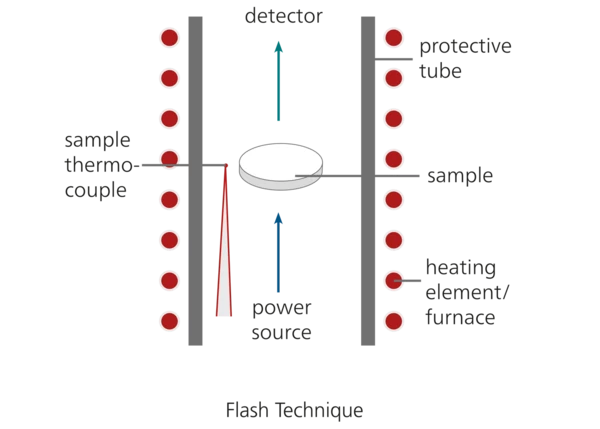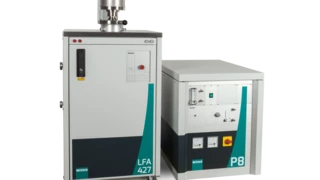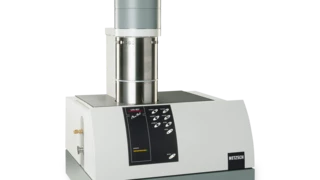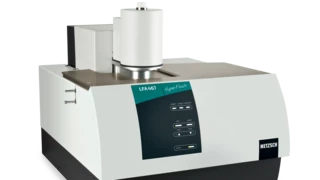Principle of the LFA Method
The laser or light flash method dates back to studies by Parker et al. in 1961.
In carrying out a measurement, the lower surface of a plane parallel sample (see fig. 1) is first heated by a short energy pulse. The resulting temperature change on the upper surface of the sample is then measured with an infrared detector. The typical course of the signals is presented in figure 2 (red curve). The higher the sample’s Thermal DiffusivityThermal diffusivity (a with the unit mm2/s) is a material-specific property for characterizing unsteady heat conduction. This value describes how quickly a material reacts to a change in temperature.thermal diffusivity, the steeper the signal increase.
a: Thermal DiffusivityThermal diffusivity (a with the unit mm2/s) is a material-specific property for characterizing unsteady heat conduction. This value describes how quickly a material reacts to a change in temperature.Thermal diffusivity
ρ: DensityThe mass density is defined as the ratio between mass and volume. Density
cp: Specific Heat Capacity (cp)Heat capacity is a material-specific physical quantity, determined by the amount of heat supplied to specimen, divided by the resulting temperature increase. The specific heat capacity is related to a unit mass of the specimen.Specific heat capacity
λ: Thermal conductivity
T: Temperature
Using the half time (t1/2, time value at half signal height) and sample thickness (d), the Thermal DiffusivityThermal diffusivity (a with the unit mm2/s) is a material-specific property for characterizing unsteady heat conduction. This value describes how quickly a material reacts to a change in temperature.thermal diffusivity (a) and finally the Thermal ConductivityThermal conductivity (λ with the unit W/(m•K)) describes the transport of energy – in the form of heat – through a body of mass as the result of a temperature gradient (see fig. 1). According to the second law of thermodynamics, heat always flows in the direction of the lower temperature.thermal conductivity (λ) can be calculated by means of the formula in figure 2. Furthermore, the specific heat (cp) of solids can be determined using the signal height (ΔTmax) compared to the signal height of a reference material.
LFA investigations generally take much less time than Thermal ConductivityThermal conductivity (λ with the unit W/(m•K)) describes the transport of energy – in the form of heat – through a body of mass as the result of a temperature gradient (see fig. 1). According to the second law of thermodynamics, heat always flows in the direction of the lower temperature.thermal conductivity measurements by means of GHP (Guarded Hot Plate) or HFM (Heat Flow Meter).




